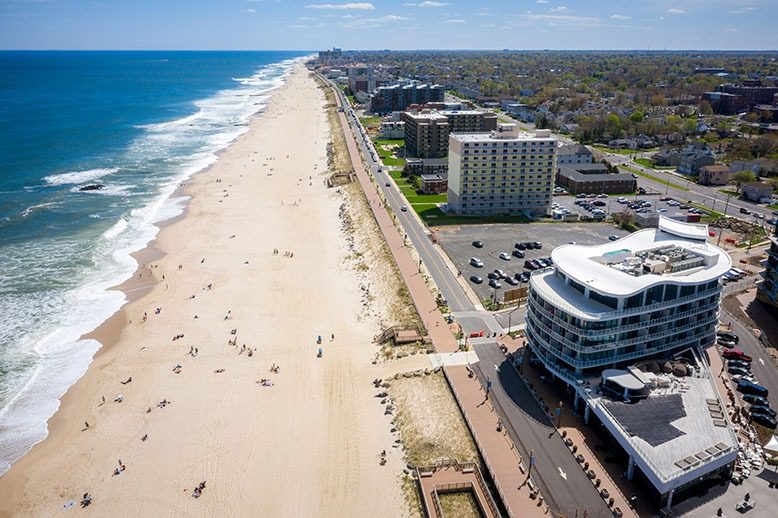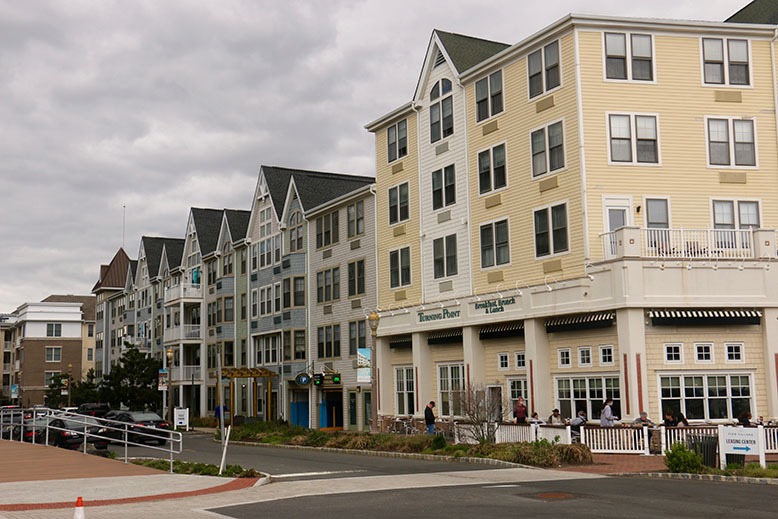
The road that hugs the ocean in Monmouth County is mostly just two lanes. It passes through a necklace of towns that each has about a mile or two of beachfront, some even less—except for one, which has more than 4 miles. In Long Branch, the road widens to four lanes for a stretch, and you have to go all the way south to Long Beach Island to find another municipality with that much beach.
Bordering that road in Long Branch are clusters of buildings taller and denser than almost anywhere else along the Jersey Shore. When palm trees are trucked in to some spots in the summer, it might be mistaken for a scale model of South Florida.
“The vast ocean, the little streets” is how Robert Pinsky, the only three-term U.S. poet laureate and a third-generation native of Long Branch, described the city he once said “all of my poems are about.”
The little streets near that vast ocean—transformed by more than a century of storms, fires, and shifting demographics, economics and politics—are mostly gone now, replaced by a waterfront corridor of condos, apartments, hotels, restaurants and shops that seems to sprout a shiny new building, or two or three, each season. The Shore spotlight has shined most brightly lately on Asbury Park, just a few miles south, with its hip-chic vibe, its music scene and its Springsteen echoes. But it’s Long Branch whose look and feel have changed the most—change that has been decades in the making, but that has shifted into overdrive in the last few years.

Condos line Melrose Terrace in Pier Village. Photo: Shutterstock
Those 4 miles of beach gave Long Branch a broader canvas to work with as it created a new version of itself, remaking its oceanfront more dramatically than any of its neighbors have remade theirs. It is no longer the fashionable resort where President Ulysses S. Grant kept the Summer White House at 995 Ocean Avenue, and where six other presidents followed, vacationing in the grand houses and hotels that once commanded the bluffs along the beach; but neither is it the fading city of “an abandoned boardwalk” and “the downtown that the shopping centers killed” that Pinsky lamented in his 1971 poem, The Destruction of Long Branch, N.J.
“Along the oceanfront, there’s not a lot of land left,” says Mayor John Pallone, pointing out the new buildings as he drives along Ocean Boulevard.
Pallone, 66, is a fourth-generation Long Branch native, son of a police detective sergeant and brother of the congressman who has represented the city since 1988, Frank Pallone. His perspective on the city is deep enough that, when he passes Pier Village, the signature waterfront redevelopment project, he notes not just where it has expanded lately, but what once stood on the long-gone amusement pier from which it took its name.
“The Haunted Mansion,” he says. “Remember those old TV ads?” The ads were a staple of late-night TV in the 1980s, a lurid parade of vampires and ghouls. “The most bizarre, the most terrifying collection of horror in the world,” the voiceover warned. “It’s waiting for you.”
It wasn’t waiting for anybody anymore, and neither was much else, after a massive fire destroyed the pier and part of the boardwalk in June 1987—an event that marked the end of one era in the city and planted the seeds for another.

Pier Village from the air. Photo: Shutterstock
Long Branch once boasted that it was “America’s First Seashore Resort,” but what did that mean when ferries had long ago stopped bringing gambling swells from New York to the casinos; when air travel had since upended vacation habits; and when the amusements weren’t enticing enough to compete with other Shore boardwalk towns?
“Everybody was still thinking amusements and entertainment,” says Adam Schneider, a lawyer who was elected mayor in 1990 and then reelected seven more times before Pallone defeated him in 2018. “Then we brought in planners and they said, ‘You’re trying to recreate what you had before, and it failed.’”
The strategy shifted to mixed-use residential and retail that didn’t shut down after Labor Day. Conceiving it was one thing; building it proved quite another. Pier Village opened in 2005, but further redevelopment plans stalled in a heated eminent-domain battle when some property owners fought the city’s effort to acquire their properties. The suit was eventually settled and the redevelopment plans for the oceanfront north of Pier Village scaled back. Further building slowed through the recession, but gradually, the steel skeletons of long-gestating projects started rising again. “If you told me then how long it was going to be, I might have said, ‘I don’t know if I really want to be in for this,’” Schneider says. “The flip side of that is that you learn fairly quickly, you’re either in this for the long haul, or don’t bother.”
The oceanfront is the city’s most valuable asset and its fiscal engine, but as the buildings, and Schneider’s years in office, multiplied, some wariness set in among residents who don’t live along it. A main theme of the 2018 election for mayor and council was that the city’s balance had tipped too far to the east of Ocean Boulevard.
“He did a lot of good stuff for this town,” Councilman Mario Vieira says about Schneider. “But the last two terms, they were giving away too much, too many abatements on the oceanfront, and the residents got nothing out of it.”
Vieira, 58, is a union mason and the first member of Long Branch’s large Portuguese community to serve on the city council. He arrived in 1975, number 11 in a family of 15 children, knowing no English, and soon started working as a dishwasher at a bar on the boardwalk. “It’s 100 percent better now than it was back then,” he says about the boardwalk. “There was a lot of crime, a lot of drugs. I commend the previous administration; they got rid of all that stuff.”
The beachfront redevelopment is so deeply rooted now and the demand for units there so high that tax abatements are no longer needed to attract builders. That has allowed the administration to turn more attention to the parts of the city that felt neglected—the parts that Mayor Pallone likes to highlight when giving a tour. “We’re such a diverse community,” he says: African Americans, Portuguese, Brazilians, Sephardic Jews, and still many multigenerational Italian families like his own. “I wanted to make Long Branch inclusive to all in its diversity, so it wasn’t just along the oceanfront.”
He stops at Jackson Woods Park, a leafy oasis refurbished lately by volunteers; at the community pool that opened last year; at the old bank on Broadway that is now an arts and cultural center; and at the church under restoration on Ocean Avenue where seven presidents worshiped.
Heading back to City Hall, Pallone passes a fenced-off oceanfront parcel south of Pier Village that, although empty since last year, illustrates the city’s evolution. “That was Seaview Towers,” he says, referring to the apartment buildings that had stood there, vacant and crumbling, for 15 years. “We worked hard to get them taken down.”
They were the first beachfront high-rises when they opened in 1955 as Scott Towers, built by local developer William Marlin and named for his grandson Scott. Excavation for the towers uncovered remnants of the 19th-century hotel that had once stood there, the Scarboro. Among the finds were four carved-stone seashells with an S, for Scarboro.
“Because it was Scott Towers, we thought it was apropos to use them as cornerstones,” says Howard Marlin, 93, son of William, father of Scott, and a former longtime member of the Long Branch Planning Board. He fashioned a time capsule and placed it behind a cornerstone during construction. His father sold the buildings in 1960, and they were renamed Seaview Towers.
“I never thought I’d be around to see the buildings come down,” he says, but when they did, he asked the demolition company for the time capsule. They didn’t find it, but they did find cornerstones. “It’s a bittersweet thing, but the city has evolved into the 21st century.”
Planned for the site now is a condominium complex called the Atlantic Club—two seven-story wings connected around a pool plaza that would look at home in Miami Beach. “We scaled down the number of units and lowered it from the original plan,” Pallone says. The redevelopment agreement with the city also calls for a narrow, green ribbon of park. “We wanted to have it more open so there’s a place for the public.”
And the public keeps coming, filling the beach in the summer and strolling the boardwalk through the year. “I visit the ocean almost every day,” says Vieira.
The mayor he helped oust is a regular there, too. “It took me about five minutes to recover from losing,” says Schneider, who has stepped away from city politics. He bodyboards in the ocean year-round, and after the election, he bought a new wetsuit. “A friend of mine called to see how I was doing, and I said, ‘It’s about to be summer, and I’m going to the beach.’”
Kevin Coyne, a longtime contributor, teaches at Columbia Journalism School.
